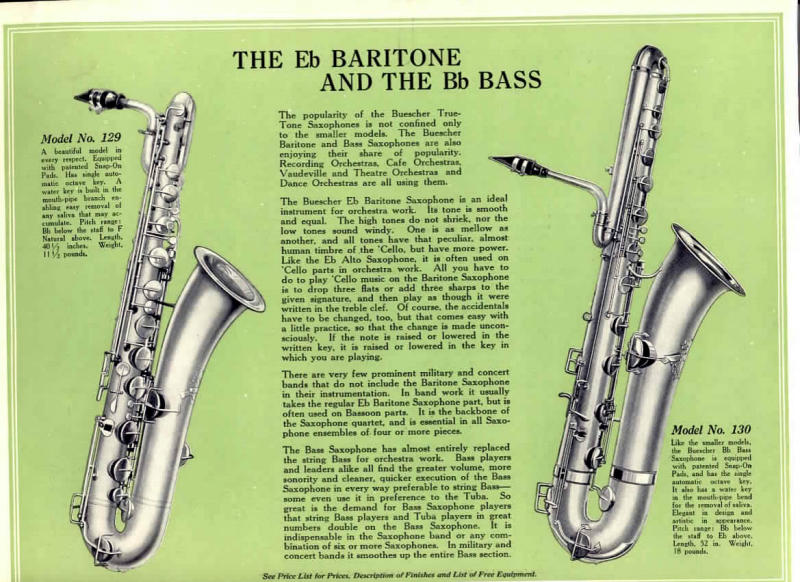Someone posted an interesting question in the Bass Saxophone Co-operative recently, regarding the differences between vintage Buescher and Conn bass saxes. The answers provided by two of the most knowledgeable, and nicest bass sax players I have come across in my 8 years in the bass saxophone world, were very interesting.
Since I have only seen one Conn bass saxophone, and never had the chance to play it, I found this information enlightening as well. I thought I’d share the knowledge here, since not all of my readers belong to the Co-op.
The original question from a Co-op member was:
What do you think about the differences between Conn bass saxes and Buescher ones (from the 1920s)? Is one mechanism or the tuning better than the other one?
Paul Coats (who I bought my 1922 Buescher bass from) replied with the following:
Both Conn and Buescher bass saxophones have similar intonation tendencies.
The middle C (C2), played with the middle finger left hand is muffled, due to the closed pads below the open pad. The side C fingering has a better, more resonant tone.
2nd space A (A1) tends to be flat, while A2 tends to be in tune. To correct this, for sustained notes, play the A1 with the addition of the G# key.
Middle D (D2), and to a lesser extent, Eb2, tends to “crack” and produce notes a 5th above, that is, A and Bb. Adding the D palm key will stabilize the D. As you gain experience with the bass this problem will tend to go away. I have seen this same problem with young baritone sax students.
The palm key notes tend to be sharp, but this is due to using a mouthpiece with too large chamber.
Both are well made instruments, but the tone is different. The Conn sounds more “tubby”, or like a tuba. The Buescher has, as others have said, a darker, more classical tone.
But I think the differences are very minor. I would be perfectly satisfied with either instrument.
Bert Brandsma, the Dutch bass player who has probably only been surpassed by Adrian Rollini with the number of gigs played by a bass saxophone player, and performs on vintage Conn saxophones exclusively, said:
A lot depends on the year the sax was built in. I played 3 Conns and 2 Buescher basses. Besides I tried several stencils like Martin, an old Keilwerth and a Pan American, all from the Conn factory.
I would advise to look for basses not older then say 1920. Before that, intonation is often really problematic. That means in general that you would need a Conn bass with rolled toneholes.
After 1930 Buescher and Conn basses are very much the same. Probably since after the great depression there were so few basses made. I suspect they were working together on the few basses they sold in that era.
With the horns dating from the 1920s I prefer the Conns, the keywork is better for my hands, and the two octaves have more the same sound quality. With the Buescher I felt a kind of register break, between first and second octaves. Besides I’m kind of crazy about the rolled toneholes.





Helen, I have been fortunate to play quite a few old Conn bass saxes and also 2 Bueschers. Here is what I know. The very early Conns have a neck that is smaller in diameter. I noticed this when I overhauled one and noticed that the early Conn neck could use a baritone sax mouthpiece without modification. Later Conn basses came with a mouthpiece that had a backbore of almost .75″. Baritone mouthpieces need to be reamed out to fit the later horns.
Colin Stetson sent his 2nd Conn bass sax to Matt Stohrer for an overhaul. Matt did a great job, but the later horn didn’t play like Colin’s first (earlier) Conn bass. I sent Matt the specs for my Pan American (late Conn) neck, and we noticed that it was the change in the neck dimensions that caused Colin’s 2nd bass sax to play differently. I think Buescher bass necks are more like the early Conn necks, but I never measured one.
I noticed that the high D and Eb toneholes on Buescher basses were smaller than those holes on Conns, and they were located farther from the mouthpiece. Intonation of high D & Eb (above the staff) is MUCH better on Bueschers than Conns. That changed when Conn went to basses with high E & F keys. Then they changed the whole horn. Earlier (almost all) Conns are so sharp on D & Eb above the staff that I think the palm keys were intended to be used as alternate fingerings for D & Eb in the staff, because so many people have problems with those notes.